
Nikon is famous for the consistency of their F-Mount over 57 years. But when it comes to the eyepiece mount of Nikons SLRs and DSLRs the history is a bit less glorious (of course, the lens mount is much more important than the eyepiece mount).
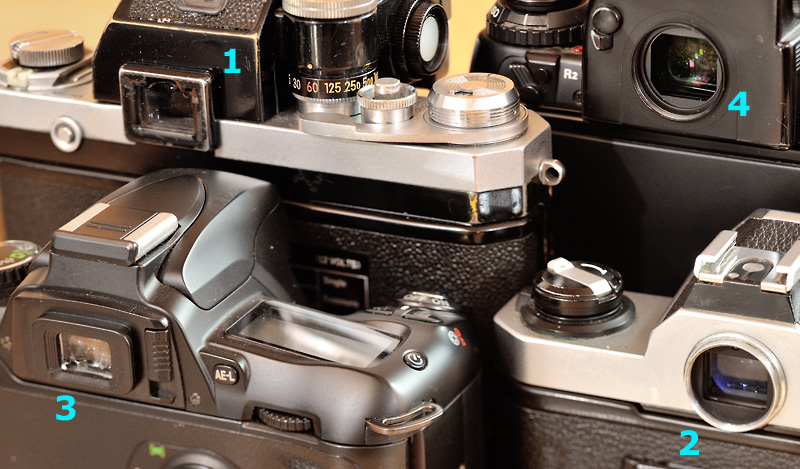
|
|
From top left to bottom right: Nikon F Photomic (introduced 1962), Nikon F4 (1988), Nikon F75 (2003) and Nikon FM2 (1981). |
1: old rectangular mount
Introduced in 1959. This mount was used exclusively for the Nikon F in the very first years.
2: 19mm screw mount
Introduced in 1962 with the Nikkorex F. Later Nikon F models also got this mount. Used until 2006 (the last camera with this mount was the FM3a).
Most SLRs with the 19mm screw mount were delivered with a plain-glass eyepiece. The only exceptions were the F and F2 models.
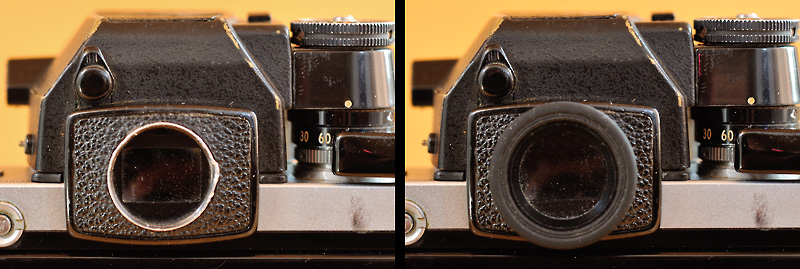
|
|
If you are looking for an eyepiece for your F or F2: the eyepiece of the F3 (DE-2 finder) is perfect! Shown here: an F2AS. |
3: (newer) rectangular mount
Every consumer (D)SLR since 1979 has got this mount (starting with the EM). Nikon has also used it for four semiprofessional DX DSLRs: D100, D200, D300 and D300s.
The DSLRs with the rectangular mount come with a rubber eyecup. In contrast, the SLRs with the same mount were delivered without an eyecup or something similar. Eyecups were only available as optional accessories.
4: 22mm screw mount
Introduced in 1981 with the DE-3 High-Eyepoint finder for the F3. Since then, every professional SLR/DSLR got this screw mount. Starting in 1988 (with the F-801/N8008) most semiprofessional bodies have got this mount, too. Exceptions are the FM2/T, FM3a, D100, D200 and D300(s). Note: the just-announced D500 has got the 22mm screw mount!
Every SLR and DSLR with a 22mm screw-mount has a mounted eyepiece of plain-glass by default, the current version is called DK-17. Starting with the D2 series Nikon introduced an important improvement of this mount: the safety lock. Screwing off the the eyepiece or some other finder accessories is only possible if the eyepiece shutter is closed. Thus, losing the eyepiece is no longer an issue. Please note: the eyepieces of the professional SLRs were bigger than those of the semiprofessional cameras. You won't be lucky with an F4 eyepiece on your F-801/N8008, because you can't open the camera back...
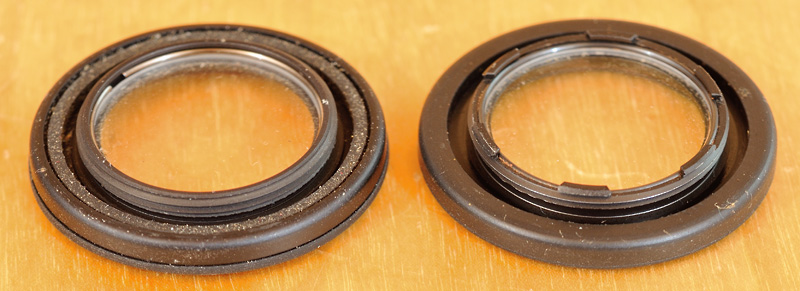
|
|
Eyepieces with 22mm screw mount - on the right a newer one with safety lock. |

|
|
Safety lock on the camera side (shown here: the D4). |
|
|
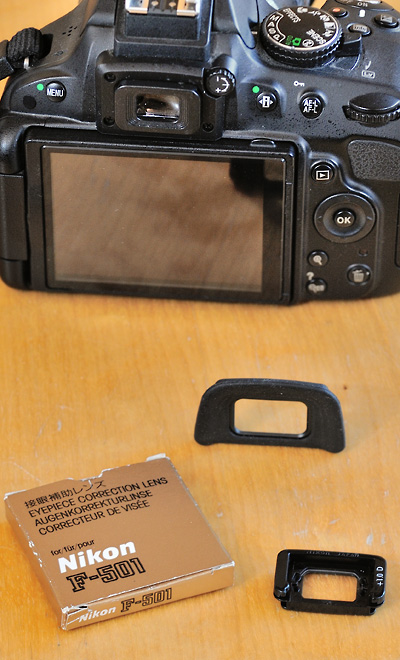
|
|
Every current Nikon DSLR (shown here a D5100) has got a built-in dioptre-adjustment control. If you need more correction you need an additional correction lens. Just remove the rubber eyecup and mount the correction lens instead. Usually, older models for the same mount will work, but try to mount it carefully. |
By default the eyepiece of a Nikon (D)SLR has -1 dioptre. That is okay if you don't wear glasses.
Wearers of glasses will need a dioptre adjustment for the eyepiece if they want to look through the viewfinder without glasses.
For older cameras you need a "dioptre-adjustment viewfinder lens" aka "eyepiece correction lens" aka "correction eyepiece" (Nikon does not have a consistent terminology here). Such lenses are available in the range from -5 to +3 dioptres.
The F4 was the first Nikon SLR with a built-in dioptre-adjustment control. Nikon's current DSLRs have got that feature, too. The correction range is -3 to +1 dioptre. Only if you need more correction you still need an additional correction lens.
The current correction lenses are the DK-17C for the 22mm screw mount (with safety lock) and the DK-20C for the rectangular mount.
For the 19mm screw mount there is a great variety of correction lenses, see examples in the image below. Of course, all of them can be mounted on every camera with the 19mm screw mount. But be warned: if you use the larger one shown on the left in conjunction with a body of the FM/FE-series, you can't open the camera back! With a Nikkormat, a Nikon F, F2 or F3 it works fine.

|
|
Eyepiece correction lenses with 19mm screw mount. Please note: the "0"-model in the middle is a real correction lens because the eyepiece of an SLR has a power of -1 dioptre by default. |
Taking photos without your eye to the viewfinder implies the risk of straylight that interferes with proper exposure metering or even the image itself. It is a good idea to shade or better to close the eyepiece in such situations. Some cameras have a built-in eyepiece shutter, which is very convenient.
In 1976 Nikon introduced the DP-3 finder for the F2 (together called F2SB). It was Nikon's first finder with an integrated eyepiece shutter. It became standard: the F2AS and every later professional SLR or DSLR have got an eyepiece shutter. Some semiprofessional cameras got one, too: Nikon FA, F90/N90, F90x/N90s, D700, D800, D810 and D500.

|
| On the left the real thing: eyepiece shutter of the F4. On the right the poor man's version: eyepiece cups (shown here: DK-5 and DK-8). |
Cameras with the rectangular mount come with the DK-5 eyepiece cup. The F-801/N8008, F-801s/N8008s and F100 had the DK-8 included in delivery and the Df comes with the DK-26. As far as I know, there are no eyecups for the 19mm screw mount.
Please note: if you switch your DSLR into live view mode, the finder will also be closed.
There are three eyepiece adapters. They are made for using 19mm screw mount accessories in conjunction with a camera with a...

|
| Nikon eyepiece adapters, from left to right: "eyecup adapter", DK-22, DK-7. |
The 19mm to 22mm adapters offer a stable mount for accessories. The first version DK-1 was introduced with the F3HP. The DK-7 came in 1988 and the current DK-18 in 2006.
In contrast the plastic adapters are unstable. I often used my DR-3 right-angle finder with my D200 - around five DK-22 got broken! In the end I glued a DK-22 onto the eyepiece mount of my D200.
The Nikon eyepiece magnifier is a viewfinder accessory with a 19mm screw mount that allows to enlarge the middle of the viewfinder image with a magnification of 2x. Please note: the rest of the viewfinder is not visible. It is helpful for precise focussing, although this tool is in no way comparable to a magnifying finder (see my article Interchangeable viewfinders). The loupe can be folded up for watching the complete, unmagnified finder image. A dioptre adjustment is integrated. The first version was introduced in the 60s and just called "eyepiece magnifier", the second and still available version is called DG-2.
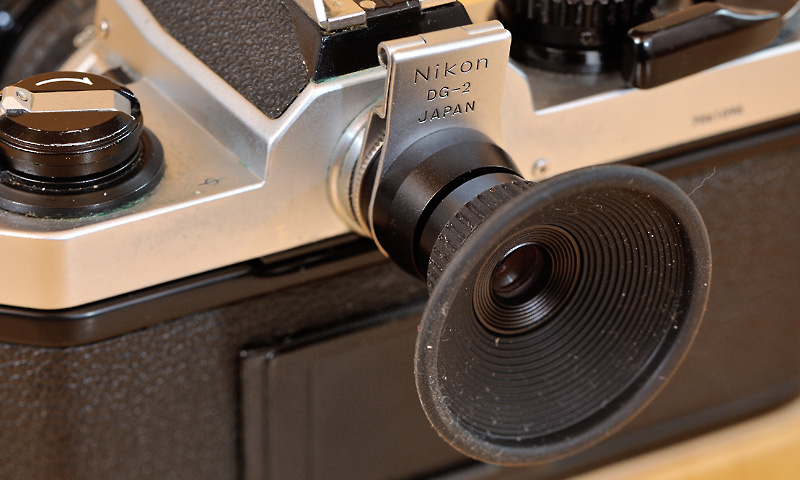
|
|
Nikon DG-2 eyepiece magnifier, mounted on an FM2. |
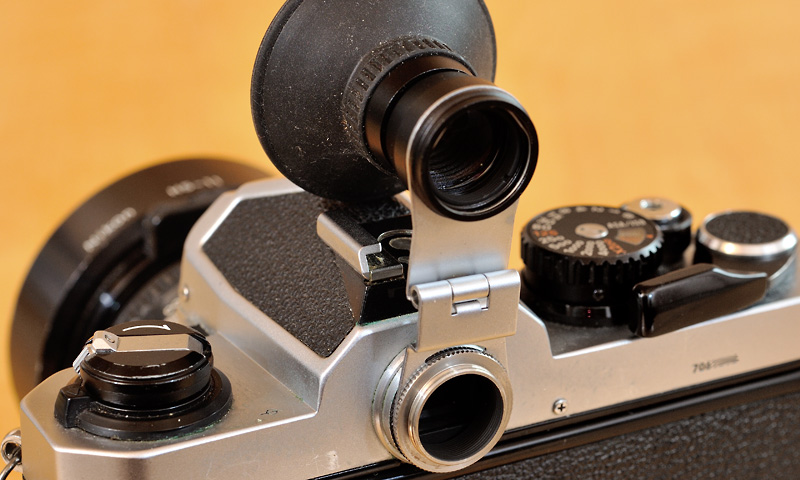
|
Due to its low weight the DG-2 is well usable in conjunction with any of the eyepiece mount adapters mentioned above.
Brought onto the market around 2006, the magnifying eyepieces are relatively new viewfinder accessories. Two versions exist: the DK-17M for the 22mm screw mount (with safety lock) offering a magnification of 1.2x and the DK-21M for the rectangular mount with 1.17x. With these eyepieces just about the entire viewfinder image is visible and precise focussing is a bit easier. In terms of optical quality the DK-17M is reported to be better than the DK-21M.

|
|
On the left: size comparison between DK-17 and DK-17M. On the right: DK-17M mounted on a D4. |
I love my DK-17M, especially when using manual focus lenses. The optical quality is very good. Little drawback: If you mount or dismount the DK-17M, you have to readjust the camera's dioptre control.
Nikon's first right-angle finder was the Nikkorex right-angle finder for the Nikkorex F. Later, a very similar type branded "Nikon" was sold, see image below. Both finders are made for the 19mm screw mount and offer a built-in dioptre adjustment. Moreover, they are surprisingly small. But there is a hitch: these early right-angle finders show a mirror-reversed image like a waist-level finder.
Later models, starting with the DR-2 in the early 70s, are much larger but show a non-reversed image.
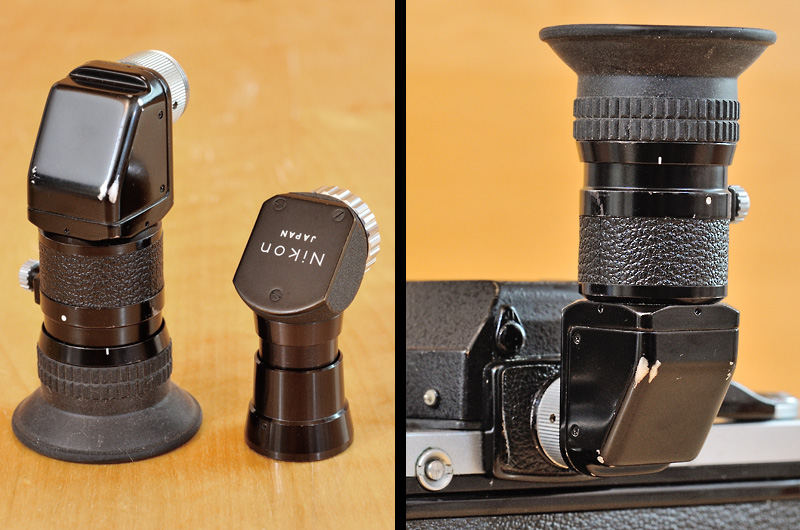
|
|
On the left: size comparison between DR-3 and a first generation right-angle finder. On the right: DR-3 mounted on an F2AS. |
The DR-2 was quickly replaced by the DR-3. I do not not know the reason for this replacement - both finders look very similar. They have got an integrated dioptre adjustment with locking screw. Both finders have a 19mm screw mount and come with an additional extension ring. The manual of my DR-3 (bought 1979) says I should use the finder including the ring for the F, F2, FM, EL and EL2 and without the ring for the Nikkormat FT series. But I normally use it without the ring, which works fine e.g. on an F2AS or on a D700. Just try it with your camera! The DR-3 was produced for many years. Accordingly, you will find a lot of second-hand offers for little money. The DR-3 works fine on the 22mm screw mount by using an adapter. But as mentioned above, adapting to the rectangular mount is critical!
In the 90s Nikon introduced the DR-4, which is very similar to the DR-3. The DR-4 also has a 19mm screw mount. But it came with an extension ring with a 19mm female thread on the finder side and a 22mm male thread on the camera side. This extension ring was named DK-12 and is also sold separately. An optional accessory for the DR-4 is the DK-13 extension ring, which is exactly the extension ring of the DR-3. The image below shows the mentioned parts:
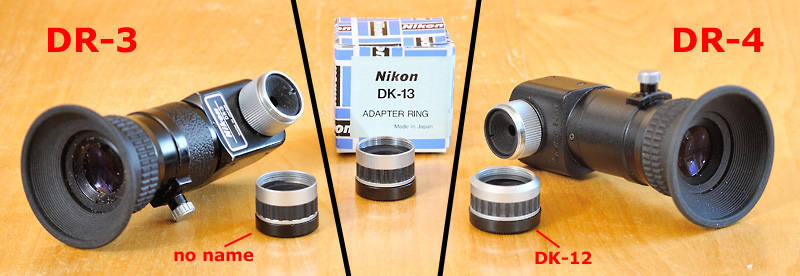
|
Around 2003 the DR-4 was replaced by the DR-5. The DR-5 is a right-angle finder with an integrated 2x magnifier that must be activated by a switch. It has a 19mm screw mount, the DK-18 adapter for the 22mm screw mount is included in delivery. Sorry, I have no experiences with the DR-5.
The DR-5 has a sibling: the DR-6 is the same thing, but with a rectangular mount! That means Nikon is not able to implement a stable adapter solution between screw mount and rectangular mount! In my eyes it is a little disaster. If a customer buys a D-810 as a first body and a D-610 as a second one, which right-angle finder will Nikon recommend?
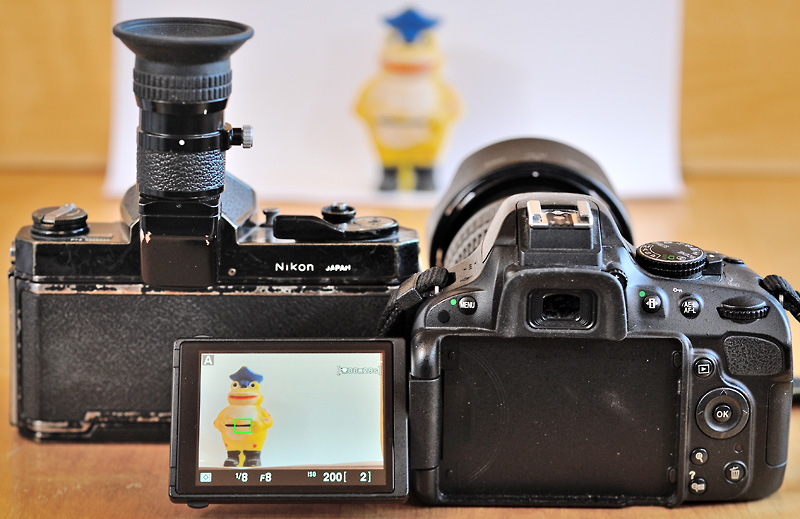
|
Our DSLRs offer live view and foldable displays. Thus, we no longer need optical magnifiers or right-angle finders. Well, that is true for some setups. But if you are in the field in bright sunlight and you want to take a low-angle shot you need a right-angle finder, because you won't see anything on your display.
But I am sure the days of right-angle finders are numbered! Nikon just annouced the DF-E1 finder. It is an electronic viewfinder for two of the new DL premium compact cameras. You mount it onto the hot shoe of the camera. It communicates with the camera via the hot shoe and it is foldable! I hope Nikon will announce such a finder for DSLRs in the near future. It would work whenever the camera is in live view mode. It would allow magnifying any part of the image and viewing the image from different angles. Besides, it would be great for IR photography.